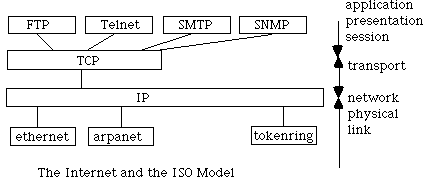
Ian Prince[2]
We will first define a few key concepts.

TCP (Transmission Control Protocol) is the transport layer above IP that ensures the connection between sender and receiver. TCP provides a virtual circuit and error detection/correction. Using TCP/IP two network hosts can communicate independently of the networks that connect them.
Above TCP/IP application oriented protocols provide higher level services.
FTP (File Transfer Protocol) allows file transfers between two network hosts. FTP servers such as nic.switch.ch provide vast collections of documents, programs and images. To overcome long-distance FTP traffic many popular FTP servers are geographically duplicated (nic.switch.ch "mirrors" many of the most popular US FTP servers). A Swiss user of the Internet will most certainly find better FTP performance connecting to a Swiss "mirror" than directly connecting U.S. server. ARCHIE servers are essentially databases that index documents from different FTP servers, largely facilitating finding where a certain file is located.
Telnet (Terminal Protocol) is the terminal access protocol. Using Telnet it is possible to run remote programs (such as databases) using a command-line interface.
NNTP (Network News Transfer Protocol) is the bulletin board protocol. NNTP allows an Internet host to participate in any of the thousand of forums ranging from technical discussions on Oracle databases (comp.databases.oracle) to cultural discussions on Switzerland (soc.culture.switzerland).
SMTP (Simple Mail Transfer Protocol) is the protocol permitting electronic mail transfers between Internet hosts.
SNMP (Simple Network Management Protocol) is the protocol to manage networks. The SNMP protocol is usually built in to network hardware such as gateways, routers and multiplexers.
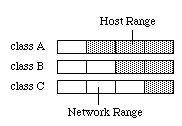
IP addresses consist of 4 octets whose values are separated by dots, for example: 136.102.233.49. The first octets provide network addressing and the last octets the host addressing. The balance between network and host addressing is determined by the class of network: A, B, or C.
The InterNIC Registrar is responsible for the distribution of network addresses. The hierarchy is usually the following:
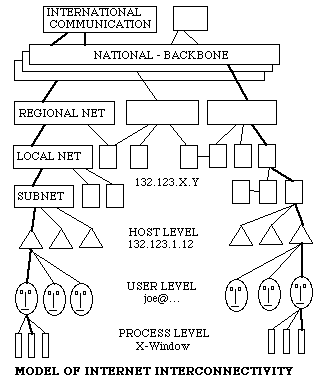
The number of Internet users can only be estimated. Currently (March 1995) it is estimated that there are almost 5 million hosts connected to the Internet with an annual growth rate of 50-100% (approx. 10'000 additional hosts per day). More than 10 Terabytes are currently exchanged monthly on the U.S. backbone of the Internet.
The associative link consists of a destination node and a source node, where both nodes usually reside in different documents. Using links it is possible to create a semantic web between information nodes. A reader of such documents can follow links depending on his or her interests.
Systems such a HyperCard and Oracle's on-line help already implement a simple form of hypertext, where the user navigates from one explanation to the next. More recently CD-ROMs use the same concept of hypertext navigation to present large quantities of multimedia (text, sound, images) information.
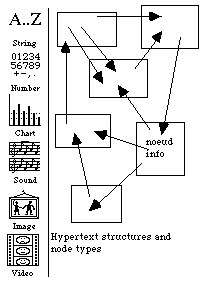
WWW browsers provide the user interface to view and navigate the hypertext. Links within a node are distinguished typographically (by underlining, for example). Clicking on a link presents the document that the link "points" to.
WWW documents, essentially, do not define how a document is to be viewed. This has allowed the development of browsers on different platforms (Windows, MacOS, UNIX, VMS) such as NCSA Mosaic, Netscape and Lynx. Each browser determines the presentation of the structural information of a WWW document.
The following shows an example of HTML use.
<TITLE>Jump in the Web</TITLE> <H1>Once Upon a Time ...</H1> Welcome to the world of HTML this is the first paragraph.<P> this is the <B>second</B> and <I>some URL</I><P> <A HREF="http://oracle.com"> at Oracle </A><P> <A HREF="http://cuiwww.unige.ch"> at SQL7 </A><P> <A HREF="http://mistral.nst.fr/~pioch/louvre"> Le Louvre </A><P> <IMG SRC="smile.gif">
Comments:
Delimiters are specifies by angled-brackets <like this> and generally go in pairs: <xxx> et </xxx>
<TITLE>Jump in the Web</TITLE> Defines the title of a document node
<H1>Once Upon a Time ...</H1> Defines a header of level 1 (out of six)
Welcome to the world of HTML this is the first paragraph.<P> Defines a paragraph
this is the <B>second</B> and <I>some URL</I><P> Defines text ornamentation (bold and italics)
<A HREF="http://oracle.com"> at Oracle </A><P> Defines a link to the Oracle HTTP server.
<IMG SRC="smile.gif"> Adds an image to the document
The following figure shows how the page is rendered by NCSA Mosaic.
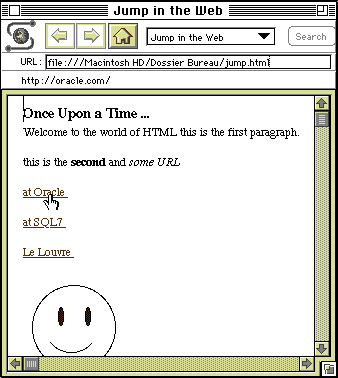
type://host:[port]/path#anchor
Anchors define a specific point in a HTML document. In Part II of this article we will show how URLs can be used to access databases via the CGI (Common Gateway Interface) mechanism.
There are basically two methods for finding information on the WWW: (1) by using compiled indexes such as the CUI's W3Catalog or (2) by serendipitously navigating links also know as "net surfing".
Here we will demonstrate a specific case of structured document conversion, where the document to be converted represents a language grammar.
BNF (Backus Naur Form) grammars of these languages are commonly available. As such we have developed tools that take a BNF grammar as input and produce an HTML hypertext of the syntax as output.
The syntactical structure of the language is defined by clauses (1). Each clause generates a textual hypertext node (2) and a corresponding syntactic diagram (3). Each clause is described by a number of keywords and reference to other clauses (the non-terminals of a clause). Each non-terminal generates a hypertext link. A keyword index is also created (4) with links to each clause it appears in. Finally all the references made to a clause are generated (5).
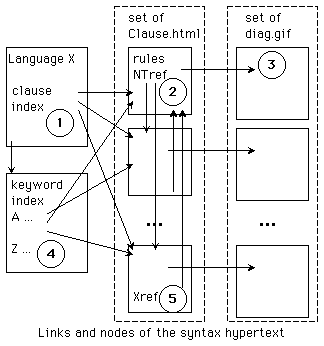
Take for example the following PL/SQL clause:
plsql_block=
["<<" label_name ">>"]
["declare" declare_spec <declare_spec >]
"begin"
seq_of_statements
["exception"
exception_handler <exception_handler>]
"end" [label_name] ";"

The following is required: each non-terminal (label_name, declare_spec, seq_of_statements, exception_handler) links to its corresponding clause; that the keyword "end" refers to plsql_block as well as function_body, if_statement, etc.; that this clause is referred to by (among others) the create_trigger clause. D
For a language such as SQL for Oracle7, one must count on approx. 250 clauses, representing many thousands of links. Automatically generating the hypertext eliminates possible errors and also allows re-generating the hypertext when the grammar changes.
We have developed a family of tools for such hypertext generation from BNF grammars:
DIAGS: draws the syntactic diagrams given a BNF grammar. The BNF grammar is actually converted into drawing primitives that are then interpreted to produce the diagram itself.

RULES: creates both the clause index and the nodes for each index. Each keyword is displayed in bold and each non-terminal creates a link. The corresponding syntactic diagram is also added to the clause-node.
XREF: creates an index of all the calling clauses and adds these to the clauses creates by RULES. This technique can be extended to other information pertaining to clauses, such as explanations, examples, etc.,.
KEYW: creates an index of keywords and defines all the links to the corresponding clauses.
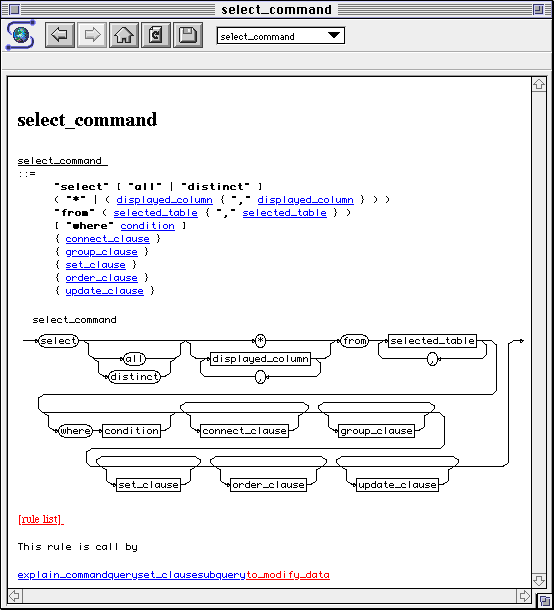
We have currently used the toolset for generating hypertexts for SQL, PL/SQL et ADA[3].
The most difficult part of this technique is describing the languages' BNF grammars. The decomposition of the grammar into clauses depends much on the goals of the hypertext. For the Ada language, the decomposition is the same as that of the Ada standard. For SQL and PL/SQL we have taken a different approach, trying to regroup a language concept in each clause (although the decomposition still resembles the one chosen by Oracle...). For a language the size of PL/SQL, one must count on two days work in defining the grammar and half a day to generate the hypertext.
WWW Servers can reflect a companies image. A number of applications are still to be discovered, but one can already cite:
For the first time a unified vision of information is possible.
access point to the BNF hypertexts for SQL, PL/SQL, and Ada.
http://cuiwww.unige.ch/db-research/Members/jg/jg.html
http://cuiwww.unige.ch/~prince
information about the authors
http://cuiwww.unige.ch/
the CUI server at the Univerity of Geneva
http://cuiwww.unige.ch/cgi-bin/w3catalog
the CUI `s main index to the WWW
Communication of the ACM, Vol. 37, No. 2 Special Issue on Hypermedia (1994)
Communication of the ACM, Vol. 37, No. 8 Special Issue on Internet Technology (1994)
The World-Wide Web, J. December and N. Randal, Sums Publishging (1994)
Mastering the Internet, G.H. Cady and P. McGregor, Sybex (1995)
E. Krol and M. Loukides, The whole internet: user's guide and catalog, O'Reilly (1992)